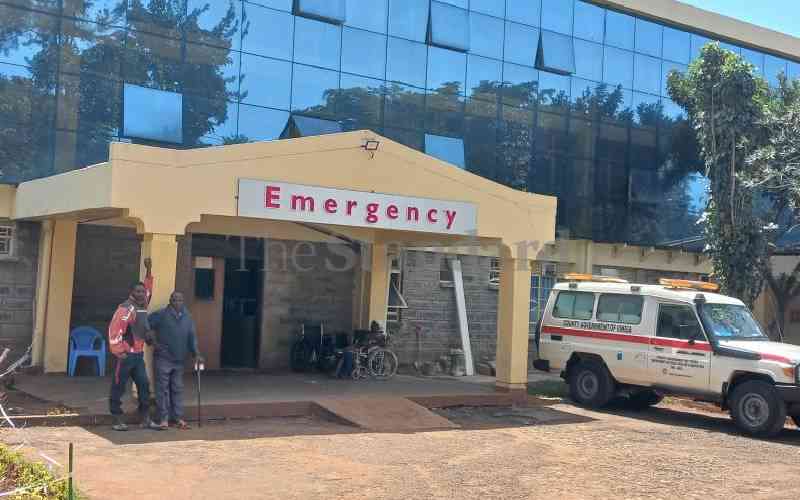DR WILBUR OTTICHILO is a scientist, Governor Vihiga County and former MP. He spoke to MAUREEN AKINYI about being a scientist in Bunge, cropping wildlife for food and eviction of people from riparian land.
You are a space scientist, why did you decide to venture into the murky world of politics?
I joined politics by accident. It was not my intention but unfortunately, I did find myself involved after those I had previously supported to lead disappointed me.
What was your experience as a senior scientist in Bunge?
Before I went to Parliament, few MPs could articulate science and technology issues. But in my two terms, I articulated many policies on science and technology and most of them were enacted during the new Constitution in 2010. I also participated in making laws like the Science, Technology and Innovation Act, the Technical and Vocational Education Training (TVET) Act, and The Climate Change Act and Education Act to mention but a few. The list might go on to over 40.
What was the transition from MP to governor like for you?
In my first term, I had to change them (people) to focus on development and not handouts as they were used to.
How would you rate your performance?
We have a good governance system that is transparent and accountable to everyone. So the next phase of my leadership if reelected will be to focus on the creation of jobs through agribusiness and small and medium enterprises and improve Technical and Vocational Training Institutes (TVETs) so that youths can get skills for job creation rather than job seeking.
To what extent is climate change a challenge for wildlife?
When I worked as a chief scientist for KWS from 1994 to 1997, climate change was already having an impact on wildlife conservation. During drought, wild animals die.
How do we tame this crisis?
We must stop ‘abandoning’ wildlife in their natural habitats but actively manage them by creating an environment where we have grass for grazers all year round. This can even mean closing some areas from grazing until we have droughts in what is referred to as rotational grazing so that animals that eat leaves and shrubs should have an all-year-round supply of food in their natural habitat.
And what happens when long droughts strike?
We should ensure that we have alternative ways of feeding wildlife the same way we feed livestock in the dry season. With climate change, we cannot afford to leave wildlife to roam and hope that they will survive on their own.
What else can be done?
Where we have large numbers of wild animal, we must be able to destock. We can either take the animals to other conservancies or we must be pragmatic by cropping the animals for food. Why let them die during drought when we can eat them as food? We must also have fences around our wildlife to avoid human wildlife conflicts.
In recent years, springs have been drying and water volumes in rivers declining. What is the problem?
Destruction of water towers or sources is to blame. We must restore these rivers and water catchment areas by, for instance, planting trees and fencing the areas. We must ensure that 30 metres around the river are left for planting indigenous trees. It is all about afforestation and reforestation is encouraged. What we have done in Mau Forest should be replicated in all our water towers.
The impacts of climate change are particularly vicious in semi-arid areas, right?
These areas used to have droughts in an 8-10 year cycles but due to climate change, they experience drought in 1-2 year cycles. People now have to change their lifestyles. They can no longer live as pastoralists but must embrace different ways of managing livestock, say destocking before droughts kill livestock or using paddock-grazing methods.
What should their leaders do?
The leadership in semi-arid areas must admit that climate change has changed their peoples’ way of life and help them to exploit new forms of livelihood such as agri-business and irrigation based farming. I would encourage them to construct dams and water pans in an elaborate water harvesting process.
Why do county governments find it difficult to protect riparian land in their areas of jurisdiction?
Most County Governments have not done public participation or created awareness on the importance of protecting riparian land. I know it is painful but county assemblies must enact laws to evict those who have encroached on riparian land and repossess that land through public acquisition. Sand harvesting should also be controlled legally.
Vihiga is among the few counties with a climate change management policy. What is the thrust of this policy?
The thrust of the policy is to create awareness on climate change and how we can adapt to climate change by rethinking our agricultural and farming systems. We must be ready to harvest water for irrigation, sustainably use river water, put up dams at the household level and use roof harvesting water method for domestic use and irrigation. Lastly, we must explore alternative sources of energy like solar and biogas and either avoid firewood or adopt the use of energy-saving stoves.
How do we adapt our agricultural and farming systems?
Conservation agriculture is the key. This is where we plant crops without ploughing. The process helps in soil conservation.
Stay informed. Subscribe to our newsletter
Your county has a relatively high population density. What is your strategy for food security?
High population density is good because manpower is a critical resource. We are, however, shifting to agribusiness and avoiding maize, which is uneconomical on our small pieces of land and opting to grow high value crops like horticulture. We also focusing on vegetables, chicken, dairy, rabbit farming and bee-keeping.
 The Standard Group Plc is a
multi-media organization with investments in media platforms spanning newspaper
print operations, television, radio broadcasting, digital and online services. The
Standard Group is recognized as a leading multi-media house in Kenya with a key
influence in matters of national and international interest.
The Standard Group Plc is a
multi-media organization with investments in media platforms spanning newspaper
print operations, television, radio broadcasting, digital and online services. The
Standard Group is recognized as a leading multi-media house in Kenya with a key
influence in matters of national and international interest.
 The Standard Group Plc is a
multi-media organization with investments in media platforms spanning newspaper
print operations, television, radio broadcasting, digital and online services. The
Standard Group is recognized as a leading multi-media house in Kenya with a key
influence in matters of national and international interest.
The Standard Group Plc is a
multi-media organization with investments in media platforms spanning newspaper
print operations, television, radio broadcasting, digital and online services. The
Standard Group is recognized as a leading multi-media house in Kenya with a key
influence in matters of national and international interest.








